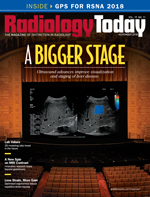 CT Slice: Lung Cancer Screening Program Guide Unveiled
CT Slice: Lung Cancer Screening Program Guide Unveiled
By Andrea McKee, MD
Radiology Today
Vol. 19 No. 11 P. 8
Lung cancer is the nation's leading cause of cancer deaths, but it's estimated that if the approximately 8 million Americans at high risk for lung cancer were screened, 25,000 lives would be saved. To ensure that all those who are eligible can access screening, it's important to encourage the adoption of lung cancer screening programs. We now can turn the tide against this deadly disease, through the availability of new screening recommendations. A pragmatic guide and toolkit that addresses common problems in implementing lung cancer screening programs among diverse institutions is now available.
In 2015, the United States Preventive Services Task Force (USPSTF) and the Centers for Medicare & Medicaid Services (CMS) announced the recommendation for screening with low-dose CT for a select group of patients considered to be at high risk for lung cancer. The guidelines from USPSTF and CMS are perhaps the most widely known, but the American Association for Thoracic Surgery, the American Lung Association, and the National Comprehensive Cancer Network offer screening guidelines as well. While these society recommendations vary slightly and provide general lung cancer screening policy statements, institutions embarking upon lung cancer screening inevitably face a myriad of granular questions of critical importance regarding program implementation, for which little to no guidance existed.
Filling the Gaps
To help fill these knowledge gaps, the American Thoracic Society (ATS) and the American Lung Association recently collaborated to develop a Lung Cancer Screening Implementation Guide. Specifically, this guide and toolkit endeavors to address challenges in designing, implementing, and conducting a lung cancer screening program by detailing various practices currently in use at diverse institutions throughout the United States. The guide is available at LungCancerScreeningGuide.org, and a subset of the information was abstracted to create a printable guide.
The guide attempts to capture the challenges or gaps faced in a variety of settings, which is why the format of a practice survey was chosen. Key summary recommendations were not possible, as some responses may be in contradiction to others. The hope is that wherever radiologists may practice, useful and relevant information would be found in the guide.
The guide is a survey of current lung cancer screening practices; it is not an official guideline or position statement of ATS or the American Lung Association. The Lung Association and ATS project chairs invited 25 members and volunteers from 16 organizations actively engaged in lung cancer screening to participate in this project. Invitations were offered in an attempt to constitute a panel reflecting the geographic locations and practice settings involved in lung cancer screening throughout the United States, as well as a diversity of backgrounds and specialties including behavioral sciences, research, quality improvement, nurse navigation, patient advocacy, and clinical care, including radiology, pulmonary medicine, primary care, oncology, and thoracic surgery.
To identify knowledge gaps, each panel member was asked to contribute common questions they have been asked about lung cancer screening. Questions were also derived from the June 2017 Massachusetts Department of Public Health Survey of lung cancer screening facilities to learn operational practices of local lung cancer screening programs and uncover facilitators and barriers to screening in their communities.
The resulting questions were pooled to create a survey that was distributed to all panel members. Panelists were asked to describe steps taken and policies implemented at their institution to address each of the survey questions. All members were encouraged to respond to each question. The survey questions and answers form the core content of the guide and were organized into several general categories. Information from previously published guidelines and policy statements was abstracted as needed for completeness.
The nine sections of the guide can be described as follows:
• Section 1 provides an overview of current lung cancer screening eligibility recommendations by USPSTF, CMS, and major medical societies as well as a summary of published policy recommendations on lung cancer screening from the ATS and the American College of Chest Physicians.
• Section 2 describes the different program structures. Program structures include decentralized, centralized, and hybrid programs, depending on the nature of participant referral and presence of central program management.
• Sections 3 to 7 contain the survey questions and responses with the source of each response identified. Topics covered include planning the lung cancer screening program, determining program eligibility criteria, prescreen counseling, screening exam acquisition and reporting, screening result management, patient tracking, registry reporting, and smoking cessation. Section 3 specifically covers forming a radiology working group, credentialing, and radiologist training, as well as establishing radiology and program quality metrics.
• Section 8 contains references and bibliography, and section 9 provides examples of a variety of documents currently used by panelist institutions to conduct their lung cancer screening program, including codes and insurance requirements, reporting templates, marketing materials, patient education tools, screening order forms, a shared decision-making conversation example, clinical decision support materials, surveillance follow-up letters, and smoking cessation resources.
It's estimated to take a decade for a new medical technique to be fully embraced by the medical community. Our hope is that this guide will help institutions adopt lung cancer screening programs and enable us to realize the lifesaving potential of lung cancer screening for all those considered at high risk.
The Lung Cancer Screening Implementation Guide is an effort between the American Lung Association and the ATS. The author is a cochair, along with Carey C. Thomson, MD, collaborating with Andrea Borondy-Kitts, MS, MPH, and Brady McKee, MD, for this summary.
— Andrea McKee, MD, serves as cochair of the lung cancer screening steering committee that developed the Lung Cancer Screening Implementation Guide. She is also division chief of radiation oncology at Lahey Hospital and Medical Center and an assistant professor at Tufts University School of Medicine.

